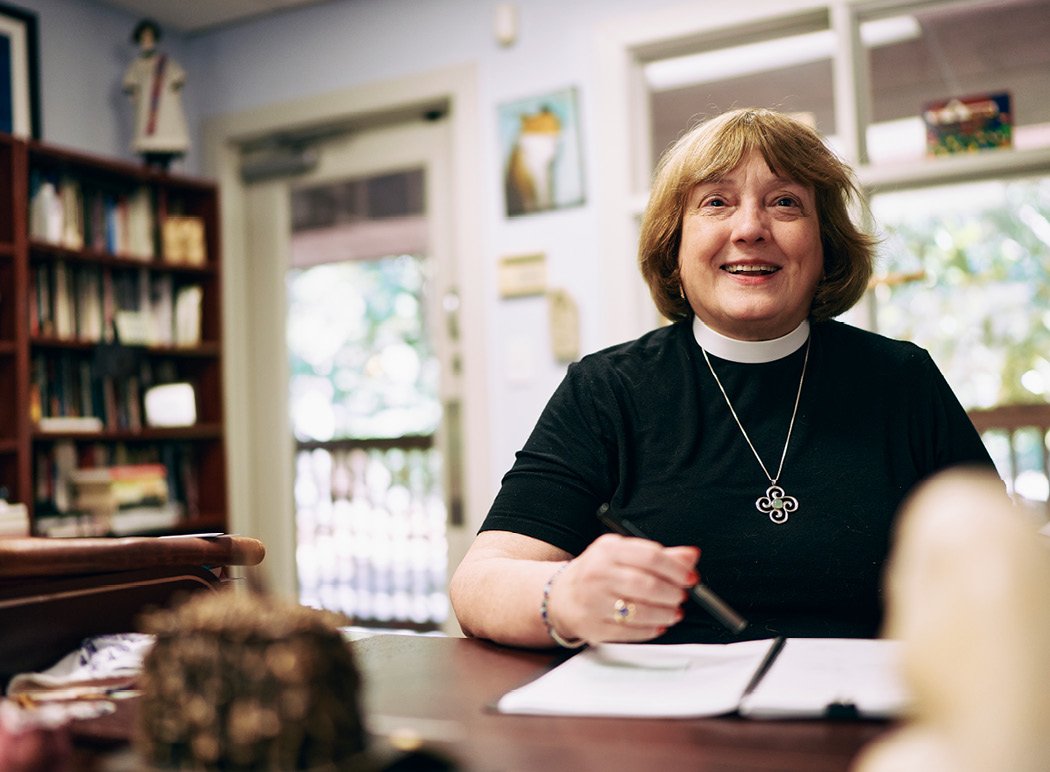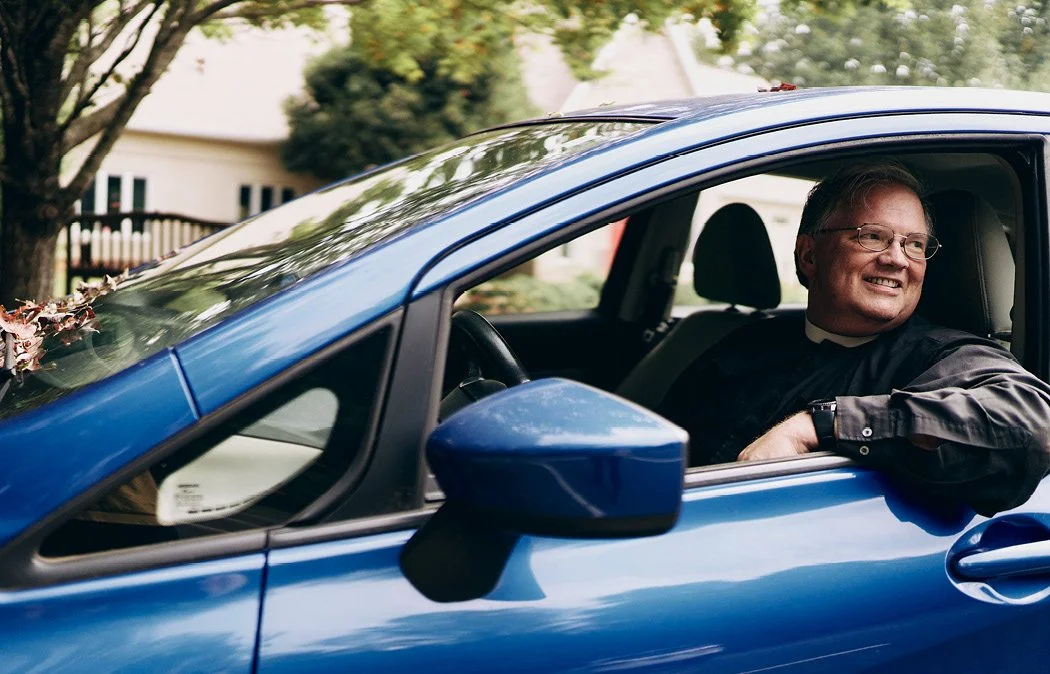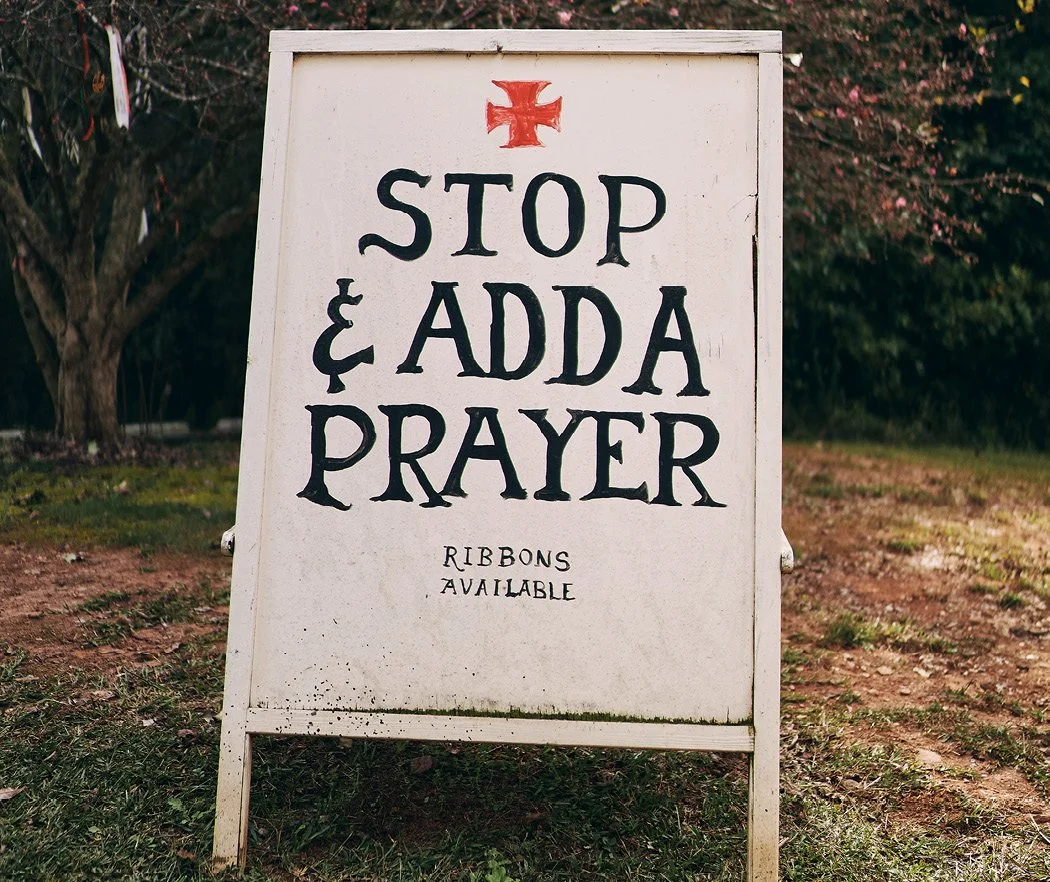Holding Tight and Looking Up

Every week during the COVID shutdown, the Rev. John Hamilton mounted his trusty steed—actually a blue Nissan Versa—and rode through the foothills of the Blue Ridge Mountains around Dahlonega to visit his flock.
Armed with a phone, a plug-in microphone, and a tripod, he recorded parishioners reading scripture and leading prayers to keep his congregation in communion as he assembled a worship service for St. Elizabeth’s Church.
Occasionally, unexpected guests made cameo appearances. When Bill Lach was reading from Philippians on his deck one morning, an erect orange sherbet-colored tail made its way across the screen. It was attached to Soju, one of the family felines. Later, during the prayers of the people, Boken, a black Labrador mix came to oversee Bill in his response as his wife, Melissa, led.
Hamilton’s own sidekick, Edward the tuxedo cat, provided a congregation of one for some of Hamilton’s homilies, but he was excommunicated when he refused to stay off the altar.
Melissa Lach said she enjoyed the on-camera readings and appreciated Hamilton’s work. “I don’t know how he did it all,” she said. “It was kind of fun seeing everybody’s porches and yards.” But, she said, she’s more than ready to get back to ordinary in-person worship, and especially choir practice. “I’m not going to lie. I’m tired of it all,” she said.
The Rev. Patricia Templeton held compline online from her kitchen table every weeknight for more than a year.
The Rev. John Hamilton tended his flock and compiled worship services by driving around his parish from home to home during the COVID shutdown.
Hamilton’s videography was just one way that priests, lay leaders, and diocesan officials innovated their way through months of isolation and uncertainty. Bishop Rob Wright kept churches informed about the latest protocols, produced his For Faith devotionals and For People podcasts, “meeting listeners at the crossroads of faith and life to explore the challenges of an ever-changing world.” He even furnished a playlist of “songs of encouragement” to boost the spirits when life seemed to become overwhelming.
The Rev. Patricia Templeton of St. Dunstan’s in Atlanta held compline from her kitchen table at 8:00 p.m. every weeknight from the spring of 2020 through Easter 2021. “I was thinking when I started that it would just be for a couple of weeks,” she said. “It was thirteen months.”
Her evening services provided a daily touchstone for parishioner Hollis Holland and his wife. “When Tricia introduced it, it just fit in,” he said. “We couldn’t go anywhere after COVID hit. It kind of kept you in touch and gave you an inner peace. It just fit into the way life should be. Now that we’re not doing it, it feels a little strange.”
Jeanne Taylor was another compline regular. Raised Catholic, she said, “I have always loved the liturgy of the Episcopal Church.” The nightly routine “gave me a more intimate connection with the church,” she said. “I’m a creature of habit. I liked very much knowing that at eight o’clock there was a place for me to go. It was an anchor in a time when it paid to be adaptable.”
Edward, the tuxedo cat, was banned from worship during COVID.
Along with new ways to gather virtually, parishes were challenged to keep up their outreach efforts and to develop new means of meeting new needs.
St. Dunstan’s vestry operated with two questions in mind, Templeton said: How do we care for one another? How do we care for the community? The church set up a relief fund for members who were thrust into financial difficulty during the pandemic and established a food pantry fund for the community with $20,000 in each. Members collected food for a pop-up food pantry, held a sock drive for the Church of the Common Ground that meets in Atlanta’s Woodruff Park, and supported a program to relieve medical debt.
St. Michael’s and All Angels in Stone Mountain continued feeding the congregation at Holy Comforter by giving monetary contributions and made sandwiches for the Church of the Common Ground congregation. Twice during the shutdown, a truck came to the church serving about two hundred people each time with grocery boxes from the Atlanta Community Food Bank. “People came through with their cars, and we delivered that way,” said senior warden Lili Phillips. “Some members took it to shut-ins who couldn’t come to get the food boxes.”
“WE’VE LEARNED THAT THE CHURCH IS NOT A BUILDING, BUT WE LOSE SOMETHING WHEN WE CAN’T GATHER.”
An outreach task force met weekly on Zoom to plan charitable efforts, she said. Among their projects were furnishing uniforms to Stone Mountain Elementary School students whose parents couldn’t afford them and setting up a minilibrary on church property.
“We really focused and are still focusing on how our church will be described after COVID,” said the Rev. Winston Arthur, rector of St. Michael’s. “Was St. Michael’s present during COVID, or were we absent?”
As a congregation of immigrants from many different countries, St. Michael’s members have relatives around the world. Many of them tuned in to online services at St. Michael’s during COVID. The church was one of several in the diocese that received grants for electronic equipment upgrades to boost online and social media presence during the shutdown and that learned that their reach extended well beyond their neighborhoods.
“COVID gave us an opportunity to pause and see how we are conducting our ministries,” said Arthur. “We have to remain relevant not only to our parishioners but to the community as well.”
St. Martin in the Fields in Atlanta also expanded its technology with a $30,000 expenditure from its endowment, said the Rev. Monica Mainwaring. A sound system broadcast the Christmas Eve service into the parking lot. During the pandemic, the church even began a new alternative worship service, called Wonder Church, especially for children and youth and hired a director of children’s ministry and communications during the shutdown.
The Rev. Ann Barker faced the difficult task of getting to know a new congregation during a time when gathering in person was impossible. Barker came to St. Joseph’s in McDonough in the midst of the pandemic after a three-year interim and several months with no supply clergy at the church. Her first interview with the vestry was in March 2020, the week that everything shut down. Her first sermon in her new role was online with no live congregation.
“The vestry had been holding things together,” she said. Vestry members called everyone each month to check in, set up organ concerts twice a week via Facebook, and the church also helped keep parish organizations operating online.
Passers-by were invited to add a ribbon and a prayer at St. Elizabeth’s in Dahlonega.
The Rev. Patricia Templeton’s cat, Dunstan, the official feline of St. Dunstan’s in Dunwoody.
Once she was in her position as rector, Barker called members to get acquainted, and, when small group gatherings were possible, met people in person, a few at a time. With a rector in place, the parish began online Sunday worship. Barker sent children in the parish an online faith exercise each week, and a church representative delivered Advent and Lenten calendars to everyone’s home.
“It was frustrating not to be able to see people at home and at church,” Barker said. “Now I can do the things I would normally do to introduce myself to the congregation.”
Cory Lites, manager of the Cathedral Bookstore, had only a slight head start on Barker in assuming her role. Lites started her job in January before things shut down in March. Lites, who is not an Episcopalian, had the idea of bringing people across the diocese together by pairing priests for a podcast series. She originally planned for five episodes, but the program continued by popular demand. The “five-week series” lasted from September to March. “We kept getting emails from people saying how grateful they were, and the priests kept wanting to do it,” she said.
Deacon Carole Maddux said she looks back with awe at how churches in the diocese and the wider church responded to the pandemic.
“Parishes had a huge, huge job,” she said. “They had to pivot very suddenly from what they had been doing forever to something entirely different that was still meaningful. The clergy had to meet the spiritual and pastoral needs of their flock and do it in a way that protected them and maintained the integrity of the Episcopal Church.”
There have been lessons, she said. “We’ve learned that the church is not a building, but we lose something when we can’t gather.”
As people continue to face uncertainly in the present and fear for the future, the church needs to continue examining its role, she said. “This is the time for the church to be relevant. This is the time for the church to be part of the community.”





